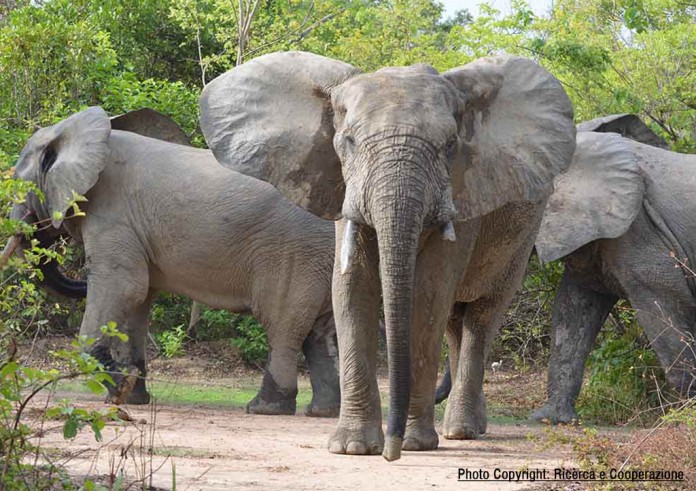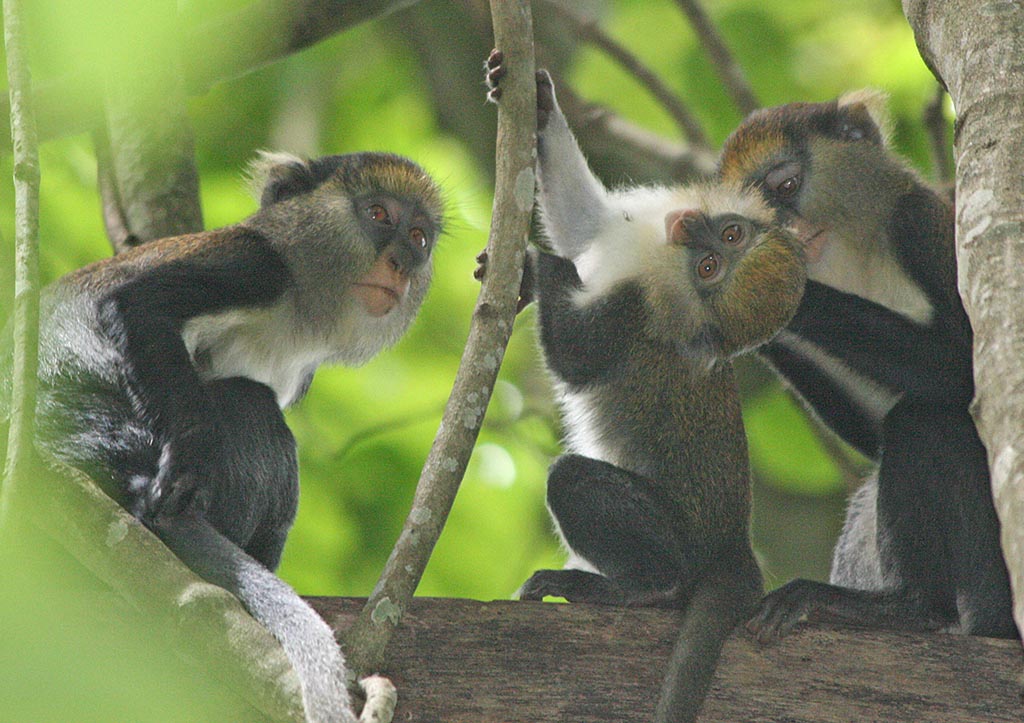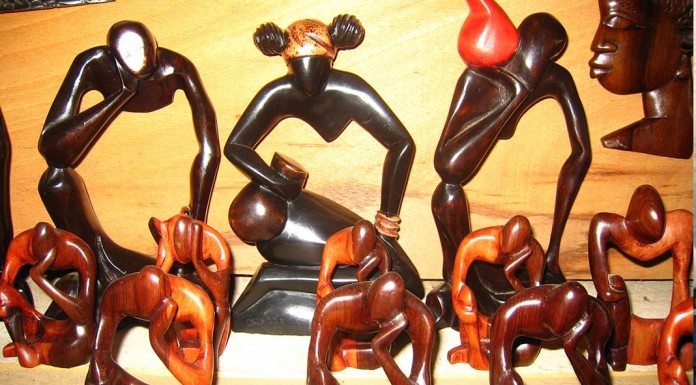
 Ghana is a nature lover’s delight. It’s sunny equatorial climate and fertile well-watered soils sustain an enchanting selection of wildlife, ranging from elephants to monkeys and marine turtles to crocodiles, as well as hundreds of colorful bird and butterfly species. More than 5% of the country’s surface area has been accorded official protection across 16 national parks or lower-profile conservation areas, of which the most popular tourist destinations are the vast Mole National Park in the northern savannah and the forested Kakum National Park near the coast.
Ghana is a nature lover’s delight. It’s sunny equatorial climate and fertile well-watered soils sustain an enchanting selection of wildlife, ranging from elephants to monkeys and marine turtles to crocodiles, as well as hundreds of colorful bird and butterfly species. More than 5% of the country’s surface area has been accorded official protection across 16 national parks or lower-profile conservation areas, of which the most popular tourist destinations are the vast Mole National Park in the northern savannah and the forested Kakum National Park near the coast.
Over recent years, Ghana has emerged as a pioneer in the field of community-based ecotourism, which aims to create a mutually beneficial three-way relationship between conservationists, tourists and local communities. The Boabeng-Fiem Monkey Santuary, home to sacred troops of mona and black-and-white colobus monkeys, led the way in 1995, and it remains the flagship for more than two dozen other community-based tourism projects countrywide. These range from the award winning Wechiau Hippo Sanctuary in the Upper West and Amansuri Wetland Sanctuary in the Western Region to cultural sites such as the Domana Rock Shrine, set in the forests near Kakum National Park, and the painted houses and pottery of Sirigu in the Upper East.
Volta Region, the most topographically varied part of Ghana, also hosts the country’s largest concentration of community-based ecotourism sites, and offers outdoor enthusiasts some superb opportunities for hiking, rambling and mountain biking. Popular attractions include the sacred monkeys of Tafi Atome, a plethora of magnificent forests and waterfalls around Amedzofe, the country’s highest peak on Mount Afadjato, and the magnificent forests and waterfalls around Amedzofe, the country’s highest peak on Mount Afadjato, and the impressive forest-fringed Wli Falls, the tallest cascade in West Africa.
Ghana is highly alluring to birdwatchers, with 725 species recorded in an area comparable to Great Britain. For casual visitors, it is colourful savannah birds such as gonoleks, rollers, parrots and weavers that tend to catch the eye, as well as the eagles and other raptors that inhabit the drier north. Serious birdwatchers, however, are likely to want to seek out the more elusive residents of the shadowy rainforests interiors of Kakum, Bui and Ankasa, as well as the exceptional variety and volume of marine species that congregate on coastal lagoons such as Keta, Songor and Muni-Pomadze.
Not least among Ghana’s Natural attractions are the suberb palm-lined beaches that line its 500km Atlantic Coastline. One of the most beautiful is Ada Foah, on the Volta Estuary, an important nesting site for endangered marine turtles. The beaches flanking Elmina and Cape Coast are ideal for those who wish to combine their sunbathing with some historical sightseeing, while their less developed counterparts further west around Busua, Axim and Beyin offe the opportunity to truly get away from it all in idyllic surrounds. And for those with limited time, there is always La or Coco Beach, lively sun-drenched expanses of white sand situated on the outskirts of the city of Accra
Various Ecotoursim Sites
Kakum Natioanl Park & Assin Attadanso Resource Reserve
Kakum and the Assin Attandanso reserves constitute a twin National Park and Resource Reserve. It was gazetted in 1991 and covers an area of about 350 km2 of the moist evergreen forest zone. The emergent trees are exceptionally high with some reaching 65 meters. The reserve has a varied wildlife with some 40 species of larger mammals, including elerpahnats, bongo, red riverhog, seven primates and four squirrels. Bird life is also varied. About 200 species are known to occur in the reserve and include 5 hornbil species, frazer-eagle owl, African grey and Senegal parrots. To date, over 400 species butterflies have been recorded. The Kakum National Park is about the most developed and subscribed eco-tourism site among the wildlife conservation areas.
Nini Suhien National Park & Ankasa Resource Reserve
Nini Suhien National Park and Ankasa Resources Reserve are twin Wildlife Protected Areas that are located in the wet evergreen forest area of the Western Region of Ghana. These areas are so rich in biodiversity that about 300 species of plants have been recorded in a single hectare. The areas are largely unexplored but 43 mammal species including the bongo, forest elephant, 10 primate species including the endangered Dina monkey and the West African chimpanzee have been recorded. Bird fauna is also rich. The reserves offer very good example of the west evergreen forest to the prospective tourist.
Mole National – Click here to Visit Mole Park
This park was established in 1958 and re-designated a National Park in 1971. It covers an area of 4,840 km2of undulating terrain with steep scarps. The vegetation is pristine Guinea savanna with gallery forests along the rivers and streams. The Park has over 90 mammal species notably elephants, buffalo, roan, kob, hartebeest, waterbuck and 4 primate species. Lion, leopard and hyena also occur and over 300 bird species have been recorded.
Paga Crocodile Pond
Located in the north-eastern border of Ghana, Paga is a sacred crocodile sanctuary.
Although crocodiles are considered as wild creatures, the Paga crocodiles are friendly and coexist with humans.
The friendly relationship between the crocodiles and humans continue to baffle the minds of many. This is in contrast to the perception of crocodiles as dangerous.
It is a customary offence to harm, kill or show any sign of disrespect to the crocodile of Paga. It is not uncommon to find children and or visitors sitting at the back of or holding the tale of a crocodile without any harm, after a sacrifice of fowl.
This is normal for the people of Paga but a mystery to visitors.
Boabeng – Fiema Monkey Sanctuary
Boaben-Fiema Monkey Sanctuary is a community based Sanctuary located at Boaben and Fiema a twin community in the Nkoranza district of Brong Ahafo Region. The sanctuary protects the headwaters of the streams that are consumed in the locality. it has a good number of the Black and White Colobus, Mona, spot nosed monkeys and a variety of birds. The monkeys in the reserve are regarded as the children of the gods of the community; therefore they are neither hunted nor killed. A system of traditional taboos and their community enforcement protected the monkeys for generations.
Recent affluence and behalf patterns, coupled with weakening of traditional enforcement of the sanctions associated with the taboo systems however threatened the continued survival of the monkeys. The situation created the need to offer statutory legal instruments to strengthen the traditional protection of the animals. Consequently, the local people were assisted to constitute the reserve under district Assembly byelaws which they are being assisted by the Wildlife Department to enforce. It is the first protected area where local indigenous protection system has been given statutory back-up enforcement of traditional/indigenous protection of wildlife in the country. The reserve is quite accessible by road and has a modest resthouse facility.
Tagbo Falls
Liate Wote, home of the serene Tagbo Falls and Mt Afadjato, the highest mountain in Ghana (2950 ft above sea level) is a peaceful village nestled at the foot fo the range of mountains that make up the Ghana-Togo border
Wli Falls
20km from Hohoe, in the Wli Natural Reserve. This waterfall is becoming very popular in the West African sub-region. It is perennial as water cascades throughout the year. It is located at the edge of the Agumatsa Wildlife Sanctuary, which has hundreds of fruit bats and a few monkeys and antelopes. The water falls from a height of about 1,600 feet
Aburi Botanical Garderns
The Aburi Botanic Garden is one of the most beautiful, peaceful and fascinating places in Ghana. Opened in March, 1890, and covering 64.8 hectares and overlooking the Accra coastal plain from an elevation of 370 to 460 metres above sea level, the Aburi Botanic Garden is a must experience for every Ghanaian as well as visitors to Ghana.
Xafi Bird Watching Santuary
The Lotor river at Xavi is nestled by coastla savannah fringing the wetlands of the Avu Lagoon. here, a great diversity of birds can be viewed whilst padding a canoe across the river.
Bunso Arboretum
Discover the beauty of Bunso Arboretum. This is a 6.5 hectare protected forest reserve, which is home to over 110 species of birds, butterflies, different kinds or herbs and indigenous trees.
Amedzofe
You are welcome to this picturesque hilltop settlement of extraordinary beauty, which rests at 2,500 ft above sea level. it is an ideal location for toursists looking for a refreshing, near temparature climate and panoramic views
Tafi Atome Monkey Santuary
Tafi Monkey Sanctuary (a sacred grove) is a traditional conservation area backed by statutory enforcement in co-operation with local communities. It is located in the Volta Region of Ghana. Tafi Atome is the home of Mona and Patas monkeys. These monkeys are found in a remnant patch of forests, which has survived fire and human disturbance around the village. These monkeys are regarded as gods and as such the natives do not kill them. They are protected by tradition.
Similar sacred groves and burial grounds protected by local people are widespread in the region. These can further be developed for small-scale tourism in the local communities to enhance rural development.
Bia National Park & Resource Reserve/Biosphere Reserve
The Bia National Park and Bia Resource Reserve constitute a twin conservation area. It is found in the transitional zone between moist-evergreen and moist semi-deciduous forest types. It covers a total area of 305.62km² of the original National Park, which was later divided into. 277.92km² Bia Resource Reserve and the other 77.7km² represent the National Park.. It is the only the Biosphere Reserve in the country.
Sixty-two species of mammals have been recorded. These include 10 primates amongst which are the Black and White Colobus, the Oilve Colobus, Red Colobus monkeys and chimpanzees. The forest elephant and the highly threatened bongo are present. Over 160 species of birds have been recorded; they include the internationally endangered white-breasted guinea fowl.
Bui National Park
Bui National Park is the third largest Wildlife Protected Area in the country. It covers 1,821km² and is bisected by the Black Volta. It is located in a typical woodland savanna zone in the Brong Ahafo and Northern Region of Ghana. It has spectacular gallery forests along rivers courses. The reserve is particularly notable for its resident Hippo population in the Black Volta. Primates like the endangered black and white colobus monkey and a variety of antelopes and birds are also present.
Digya National Park
The Digya National Park was gazatted in 1971 and covers an area of 3,478 km2 of undulating terrain with sandstone inselbergs. It is situated on the western shores of the Volta Lake. Guinea savanna woodland predominates with gallery forest along the major lines. The Park supports at least six primate species including black and white colobus, elephants and a variety of antelopes. Manatee and clawless otter are also reported to be present in the Park.
Keta Lagoon Complex Ramsar Site
The Keta Lagoon Complex, which has management area of 1200km² and lagoon area of 300km², has been established as a wetland protected area (Ramsar site) with multiple-use management and significant local participation. Apart from the conservation objective of protecting thousand of migratory birds, the mangrove forest and breeding grounds of sea turtle, it has tourism potential.
The Keta Lagoon with its brackish waters is the largest lagoon in Ghana. Its tiny islands provide sites of special attraction for Ornithologists, bird watchers and tourists in general. The site is however yet to be developed to receive tourists. It is our hope that the information that we have provided above gives enough insight into the Ghanaian wildlife resources.
Kyabobo National Park
Kyabobo National Park, a newly created Park in the Atwode traditional area, is located in the Nkwanta district of the Northern Volta Region. This park which covers an area of 359.8 km² is found in the Dry semi-deciduous forest zone and has both forest and savanna species of plants and animals. Its forests contain the nationally endangered endemic tree Talbotiella gendtii.
Animals common to the Park include, Buffalo, Kob, Warthog, Aardvark and Baboon. Threatened species of animals, which with adequate protection may recover, include Lion, Elephant, Bongo, Reedbuck and Hartebeest, which may recolonise the Park from the adjacent Fazao National Park in Togo. Tourist infrastructures are vigorously being developed in Fazaso. Kyabobo will be an attraction from Fazao.
Agumatsa Wildlife Sanctuary
Agumatsa can boast of spectacular geographical features in the district. A forty-five minutes nature walk through cool shades of trees will finally get you to Ghana highest waterfalls (800m). The magnificent view of the falls is enhanced not only by the towering face of the gorge but most extraordinarily by the several thousands of yellow coloured bats clinging to its sides.
Bomfobiri Wildlife Sanctuary
Among its protected species, Bomfobiri Wildlife Sanctuary takes pride in housing the rare bare headed rock fowl. Bomfobiri is a showcase of a rare tropical landscape.
Gbele Resource Reserve
Gbele resource reserve lies partly in the areas of Wa (regional capital), Nadowli and Tumu (district capital). The reserve is 61km away from Tumu and 89km away from Wa. Vegetation is that of open savannah woodland.
Gbele is proud to be associated with faunas such as Roan Antelope, Waterbuck, Hartebeest, Bushbuck, Savannah Duikers, Baboons, Patas monkey, Green monkey and more.
Shai Hills Resource Reserve
The reserve consists of a very striking and attractive range of rocky hills set in the middle of expansive open and wooded grassland plain. The rocks are visible in many places as impressible and sleep cliffs and large and attractive rocky outcrops. The reserve is fenced to prevent animals from straying out. It consists of a prominent isolated hill ridge of hornblende gneiss surrounded by an area of Accra Plain savannah. There are beautiful scenic views across the Accra Plain from the top.
Owabi Wildlife Sanctuary
Owabi can best be described as a secondary forest surrounding a large water reservoir. It is a tranquil site with a great variety of birdlife and fascinating forest walks. It an ideal place for winter migratory birds and hundreds of Mona Monkeys
Wechiau Hippo Sanctuary
A protected area consisting of a 40km stretch down the leangh of the Black Volta River. It is a home ro hippos, bats, chameleans, hedgehogs and many different types of lizards and snakes







